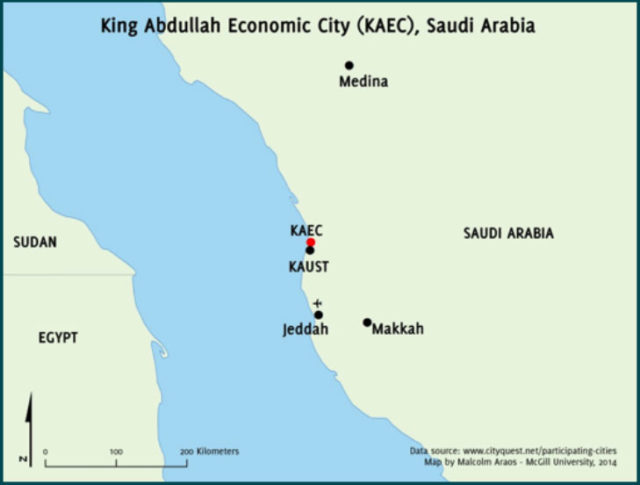KAEC: A New Hub for Saudi Arabia
December 8, 2014 — Blog
Located on the coast of the Red Sea, 100 km north of Jeddah, King Abdullah Economic City (KAEC) is one of four new cities being created in Saudi Arabia to promote industrial expansion, diversify its economy away from oil, and to provide housing and job opportunities for a young population, 65% of which are under the age of 30. Centered on a new port, the goal of KAEC is to become a global logistics and manufacturing hub. Through its ‘industrial valley’, KAEC seeks to develop sectors including logistics, fast moving consumer goods (FMCG), plastics, automotive, building materials, and pharmaceuticals.
KAEC’s goals of being socially and culturally sustainable can be seen in its most recent master plan, which promotes public transportation, walking and cycling rather than cars. Rather than canals, KAEC has prioritized a wadi system that uses the landscape and natural plants to manage flooding. The central business district is clustered around a high speed rail station that will connect KAEC with Jeddah, Makkah and Medina.

Key Facts
Timeframe: 2005-2025+
Current population: Approximately 3,000
Intended population: 1.7 million
Size of city: 181 square kilometers
Estimated investment: Over USD $100 billion
Financing: The city is being privately financed by Emaar, The Economic City (EEC), a Tadawul-listed real estate development and management company. When it offered its first successful public offering in July 2006, EEC made history: more than half of the Saudi population bought stock in it. EEC is headed by Emaar Properties PJSC and a number of high-profile investors from Saudi Arabia.
Planners / contractors: Emaar, The Economic City, the master developer of KAEC, is working with multiple partners on the project including Saudi Binladin Group, SOM (as a consultant to the master plan) and dozens of other local and international contractors.
Environmental and sustainability strategies:
- KAEC provides a dense, walkable environment that prioritizes walking, bicycling, and public transportation, and minimizes car usage.
- A flood prevention system using natural wadis capture annual flood water and allows it to trickle down and replenish groundwater.
- Indigenous desert plants are being used to minimize watering and to create a unique, local identity.
- Onsite construction materials are being re-used and recycled and the city aims to dramatically reduce waste in the city, particularly compared to the average urban Saudi household.
Industries: Port for shipping, logistics, FMCG, automotive, pharmaceuticals, food processing.
Energy sources: Connected to the national grid, captive diesel generation, solar.
Precedents: KAEC has looked to Singapore as an example of a strong economy built around a port, and a template of using public-private strategies to nurture a knowledge economy, develop advanced manufacturing and attract global talent.
Attractivity: KAEC’s approach to attract people and businesses to the city is ‘customer centric’. In other words, they are trying to provide what their ‘customers’ (i.e., those moving to the city) require in order to live and work successfully. KAEC anticipates that ‘customers’ will be attracted to the lifestyle and amenities of the city, including high-quality schools, parks, safety, community facilities, and public transportation, as well as the scenic waterfront location.
Local challenges
- Saudi Arabia’s climate poses a challenge to KAEC. Summer temperatures can pass 40°C, which means building densely and prioritizing shade is paramount.
- The lack of water will be an on-going challenge in KAEC and the region more broadly. The severe annual flooding also poses a challenge, which the wadi landscape design is intended to mitigate.
- Ensuring that services such as wireless coverage and transport provided by partners and suppliers are affordable to the end customer is an on-going challenge.
- While foreigners are eligible to purchase property in KAEC, it is still difficult to obtain visas to enter the country. This situation is currently being negotiated with the Saudi government.
This post is part of a series tied to Cityquest – KAEC Forum, our leadership event on new cities. Each week, we’ll publish extracts from the report from our inaugural Cityquest event in 2013. Access the full report here.